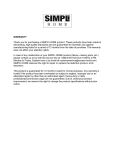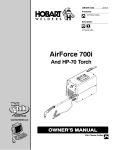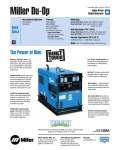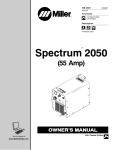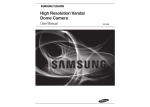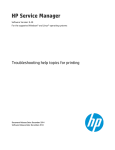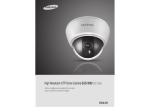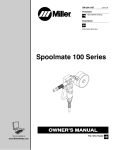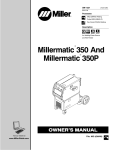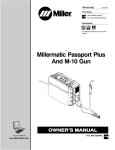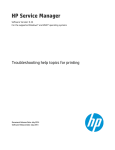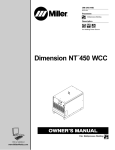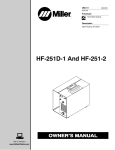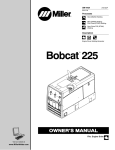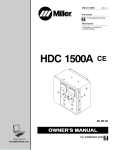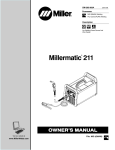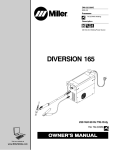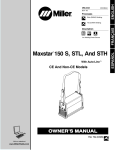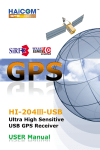Download Palm Emulator Manual
Transcript
OM-243 993C 2011−08 Description Palm Emulator Software For Axcess And Auto-Axcess Welding Power Source R Palm Emulator For Axcess And Auto-Axcess 8:00 am B Card ServicePak Visit our website at www.MillerWelds.com File: Advanced Manufacturing Systems From Miller to You Thank you and congratulations on choosing Miller. Now you can get the job done and get it done right. We know you don’t have time to do it any other way. That’s why when Niels Miller first started building arc welders in 1929, he made sure his products offered long-lasting value and superior quality. Like you, his customers couldn’t afford anything less. Miller products had to be more than the best they could be. They had to be the best you could buy. Today, the people that build and sell Miller products continue the tradition. They’re just as committed to providing equipment and service that meets the high standards of quality and value established in 1929. This Owner’s Manual is designed to help you get the most out of your Miller products. Please take time to read the Safety precautions. They will help you protect yourself against potential hazards on the worksite. We’ve made installation and operation quick and easy. With Miller you can count on years of reliable service with proper maintenance. And if for some reason the unit needs repair, there’s a Troubleshooting section that will help you figure out what the problem is. The Miller is the first welding parts list will then help you to decide the equipment manufacturer in exact part you may need to fix the problem. the U.S.A. to be registered to the ISO 9001 Quality System Warranty and service information for your Standard. particular model are also provided. Miller Electric manufactures a full line of welders and welding related equipment. For information on other quality Miller products, contact your local Miller distributor to receive the latest full line catalog or individual specification sheets. To locate your nearest distributor or service agency call 1-800-4-A-Miller, or visit us at www.MillerWelds.com on the web. Mil_Thank 2009−09 Working as hard as you do − every power source from Miller is backed by the most hassle-free warranty in the business. TABLE OF CONTENTS SECTION 1 − SAFETY PRECAUTIONS - READ BEFORE USING . . . . . . . . . . . . . . . . . . . . . . . . . . . . . . . . . 1-1. Symbol Usage . . . . . . . . . . . . . . . . . . . . . . . . . . . . . . . . . . . . . . . . . . . . . . . . . . . . . . . . . . . . . . . . . . . . . . . 1-2. Arc Welding Hazards . . . . . . . . . . . . . . . . . . . . . . . . . . . . . . . . . . . . . . . . . . . . . . . . . . . . . . . . . . . . . . . . . 1-3. Additional Symbols For Installation, Operation, And Maintenance . . . . . . . . . . . . . . . . . . . . . . . . . . . . . 1-4. California Proposition 65 Warnings . . . . . . . . . . . . . . . . . . . . . . . . . . . . . . . . . . . . . . . . . . . . . . . . . . . . . . 1-5. Principal Safety Standards . . . . . . . . . . . . . . . . . . . . . . . . . . . . . . . . . . . . . . . . . . . . . . . . . . . . . . . . . . . . . 1-6. EMF Information . . . . . . . . . . . . . . . . . . . . . . . . . . . . . . . . . . . . . . . . . . . . . . . . . . . . . . . . . . . . . . . . . . . . . SECTION 2 − CONSIGNES DE SÉCURITÉ − LIRE AVANT UTILISATION . . . . . . . . . . . . . . . . . . . . . . . . . . . 2-1. Symboles utilisés . . . . . . . . . . . . . . . . . . . . . . . . . . . . . . . . . . . . . . . . . . . . . . . . . . . . . . . . . . . . . . . . . . . . . 2-2. Dangers relatifs au soudage à l’arc . . . . . . . . . . . . . . . . . . . . . . . . . . . . . . . . . . . . . . . . . . . . . . . . . . . . . . 2-3. Dangers supplémentaires en relation avec l’installation, le fonctionnement et la maintenance . . . . . 2-4. Proposition californienne 65 Avertissements . . . . . . . . . . . . . . . . . . . . . . . . . . . . . . . . . . . . . . . . . . . . . . 2-5. Principales normes de sécurité . . . . . . . . . . . . . . . . . . . . . . . . . . . . . . . . . . . . . . . . . . . . . . . . . . . . . . . . . 2-6. Informations relatives aux CEM . . . . . . . . . . . . . . . . . . . . . . . . . . . . . . . . . . . . . . . . . . . . . . . . . . . . . . . . . SECTION 1 − INSTALLATION . . . . . . . . . . . . . . . . . . . . . . . . . . . . . . . . . . . . . . . . . . . . . . . . . . . . . . . . . . . . . . . . 1-1. Palm Emulator And USB To Serial Cable Information . . . . . . . . . . . . . . . . . . . . . . . . . . . . . . . . . . . . . . . SECTION 2 − SETUP . . . . . . . . . . . . . . . . . . . . . . . . . . . . . . . . . . . . . . . . . . . . . . . . . . . . . . . . . . . . . . . . . . . . . . . . 2-1. Loading Software For Windows XP . . . . . . . . . . . . . . . . . . . . . . . . . . . . . . . . . . . . . . . . . . . . . . . . . . . . . . 2-2. Troubleshooting Tips For Windows XP . . . . . . . . . . . . . . . . . . . . . . . . . . . . . . . . . . . . . . . . . . . . . . . . . . . 2-3. Loading Software For Windows Vista and Windows 7 . . . . . . . . . . . . . . . . . . . . . . . . . . . . . . . . . . . . . . 2-4. Troubleshooting Tips For Windows Vista And Windows 7 . . . . . . . . . . . . . . . . . . . . . . . . . . . . . . . . . . . SECTION 3 − IMPORTING AND UPDATING DATA . . . . . . . . . . . . . . . . . . . . . . . . . . . . . . . . . . . . . . . . . . . . . . 3-1. Importing Existing Files From Your Handheld Backup Files And Updating Service Pak On The Palm Emulator . . . . . . . . . . . . . . . . . . . . . . . . . . . . . . . . . . . . . . . . . . . . . . . . . . . . . SECTION 4 − HotSync PROCEDURE . . . . . . . . . . . . . . . . . . . . . . . . . . . . . . . . . . . . . . . . . . . . . . . . . . . . . . . . . 4-1. HotSync Set-up On The Palm Emulator . . . . . . . . . . . . . . . . . . . . . . . . . . . . . . . . . . . . . . . . . . . . . . . . . . WARRANTY 1 1 1 3 4 4 4 5 5 5 7 8 9 9 11 11 12 12 18 21 27 29 29 30 30 ÄÄÄÄÄÄÄÄÄÄÄÄÄÄÄÄÄÄÄÄÄÄÄÄÄÄÄÄÄÄÄÄÄÄ ÄÄÄÄÄÄÄÄÄÄÄÄÄÄÄÄÄÄÄÄÄÄÄÄÄÄÄÄÄÄÄÄÄÄ SOFTWARE LICENSE ÄÄÄÄÄÄÄÄÄÄÄÄÄÄÄÄÄÄÄÄÄÄÄÄÄÄÄÄÄÄÄÄÄÄ AGREEMENT ÄÄÄÄÄÄÄÄÄÄÄÄÄÄÄÄÄÄÄÄÄÄÄÄÄÄÄÄÄÄÄÄÄÄ ÄÄÄÄÄÄÄÄÄÄÄÄÄÄÄÄÄÄÄÄÄÄÄÄÄÄÄÄÄÄÄÄÄÄ ÄÄÄÄÄÄÄÄÄÄÄÄÄÄÄÄÄÄÄÄÄÄÄÄÄÄÄÄÄÄÄÄÄÄ ÄÄÄÄÄÄÄÄÄÄÄÄÄÄÄÄÄÄÄÄÄÄÄÄÄÄÄÄÄÄÄÄÄÄ ÄÄÄÄÄÄÄÄÄÄÄÄÄÄÄÄÄÄÄÄÄÄÄÄÄÄÄÄÄÄÄÄÄÄ ÄÄÄÄÄÄÄÄÄÄÄÄÄÄÄÄÄÄÄÄÄÄÄÄÄÄÄÄÄÄÄÄÄÄ ÄÄÄÄÄÄÄÄÄÄÄÄÄÄÄÄÄÄÄÄÄÄÄÄÄÄÄÄÄÄÄÄÄÄ ÄÄÄÄÄÄÄÄÄÄÄÄÄÄÄÄÄÄÄÄÄÄÄÄÄÄÄÄÄÄÄÄÄÄ ÄÄÄÄÄÄÄÄÄÄÄÄÄÄÄÄÄÄÄÄÄÄÄÄÄÄÄÄÄÄÄÄÄÄ ÄÄÄÄÄÄÄÄÄÄÄÄÄÄÄÄÄÄÄÄÄÄÄÄÄÄÄÄÄÄÄÄÄÄ ÄÄÄÄÄÄÄÄÄÄÄÄÄÄÄÄÄÄÄÄÄÄÄÄÄÄÄÄÄÄÄÄÄÄ ÄÄÄÄÄÄÄÄÄÄÄÄÄÄÄÄÄÄÄÄÄÄÄÄÄÄÄÄÄÄÄÄÄÄ ÄÄÄÄÄÄÄÄÄÄÄÄÄÄÄÄÄÄÄÄÄÄÄÄÄÄÄÄÄÄÄÄÄÄ ÄÄÄÄÄÄÄÄÄÄÄÄÄÄÄÄÄÄÄÄÄÄÄÄÄÄÄÄÄÄÄÄÄÄ ÄÄÄÄÄÄÄÄÄÄÄÄÄÄÄÄÄÄÄÄÄÄÄÄÄÄÄÄÄÄÄÄÄÄ ÄÄÄÄÄÄÄÄÄÄÄÄÄÄÄÄÄÄÄÄÄÄÄÄÄÄÄÄÄÄÄÄÄÄ ÄÄÄÄÄÄÄÄÄÄÄÄÄÄÄÄÄÄÄÄÄÄÄÄÄÄÄÄÄÄÄÄÄÄ ÄÄÄÄÄÄÄÄÄÄÄÄÄÄÄÄÄÄÄÄÄÄÄÄÄÄÄÄÄÄÄÄÄÄ ÄÄÄÄÄÄÄÄÄÄÄÄÄÄÄÄÄÄÄÄÄÄÄÄÄÄÄÄÄÄÄÄÄÄ ÄÄÄÄÄÄÄÄÄÄÄÄÄÄÄÄÄÄÄÄÄÄÄÄÄÄÄÄÄÄÄÄÄÄ ÄÄÄÄÄÄÄÄÄÄÄÄÄÄÄÄÄÄÄÄÄÄÄÄÄÄÄÄÄÄÄÄÄÄ ÄÄÄÄÄÄÄÄÄÄÄÄÄÄÄÄÄÄÄÄÄÄÄÄÄÄÄÄÄÄÄÄÄÄ ÄÄÄÄÄÄÄÄÄÄÄÄÄÄÄÄÄÄÄÄÄÄÄÄÄÄÄÄÄÄÄÄÄÄ ÄÄÄÄÄÄÄÄÄÄÄÄÄÄÄÄÄÄÄÄÄÄÄÄÄÄÄÄÄÄÄÄÄÄ ÄÄÄÄÄÄÄÄÄÄÄÄÄÄÄÄÄÄÄÄÄÄÄÄÄÄÄÄÄÄÄÄÄÄ ÄÄÄÄÄÄÄÄÄÄÄÄÄÄÄÄÄÄÄÄÄÄÄÄÄÄÄÄÄÄÄÄÄÄ ÄÄÄÄÄÄÄÄÄÄÄÄÄÄÄÄÄÄÄÄÄÄÄÄÄÄÄÄÄÄÄÄÄÄ ÄÄÄÄÄÄÄÄÄÄÄÄÄÄÄÄÄÄÄÄÄÄÄÄÄÄÄÄÄÄÄÄÄÄ ÄÄÄÄÄÄÄÄÄÄÄÄÄÄÄÄÄÄÄÄÄÄÄÄÄÄÄÄÄÄÄÄÄÄ ÄÄÄÄÄÄÄÄÄÄÄÄÄÄÄÄÄÄÄÄÄÄÄÄÄÄÄÄÄÄÄÄÄÄ ÄÄÄÄÄÄÄÄÄÄÄÄÄÄÄÄÄÄÄÄÄÄÄÄÄÄÄÄÄÄÄÄÄÄ ÄÄÄÄÄÄÄÄÄÄÄÄÄÄÄÄÄÄÄÄÄÄÄÄÄÄÄÄÄÄÄÄÄÄ ÄÄÄÄÄÄÄÄÄÄÄÄÄÄÄÄÄÄÄÄÄÄÄÄÄÄÄÄÄÄÄÄÄÄ ÄÄÄÄÄÄÄÄÄÄÄÄÄÄÄÄÄÄÄÄÄÄÄÄÄÄÄÄÄÄÄÄÄÄ ÄÄÄÄÄÄÄÄÄÄÄÄÄÄÄÄÄÄÄÄÄÄÄÄÄÄÄÄÄÄÄÄÄÄ ÄÄÄÄÄÄÄÄÄÄÄÄÄÄÄÄÄÄÄÄÄÄÄÄÄÄÄÄÄÄÄÄÄÄ ÄÄÄÄÄÄÄÄÄÄÄÄÄÄÄÄÄÄÄÄÄÄÄÄÄÄÄÄÄÄÄÄÄÄ ÄÄÄÄÄÄÄÄÄÄÄÄÄÄÄÄÄÄÄÄÄÄÄÄÄÄÄÄÄÄÄÄÄÄ ÄÄÄÄÄÄÄÄÄÄÄÄÄÄÄÄÄÄÄÄÄÄÄÄÄÄÄÄÄÄÄÄÄÄ ÄÄÄÄÄÄÄÄÄÄÄÄÄÄÄÄÄÄÄÄÄÄÄÄÄÄÄÄÄÄÄÄÄÄ ÄÄÄÄÄÄÄÄÄÄÄÄÄÄÄÄÄÄÄÄÄÄÄÄÄÄÄÄÄÄÄÄÄÄ ÄÄÄÄÄÄÄÄÄÄÄÄÄÄÄÄÄÄÄÄÄÄÄÄÄÄÄÄÄÄÄÄÄÄ ÄÄÄÄÄÄÄÄÄÄÄÄÄÄÄÄÄÄÄÄÄÄÄÄÄÄÄÄÄÄÄÄÄÄ ÄÄÄÄÄÄÄÄÄÄÄÄÄÄÄÄÄÄÄÄÄÄÄÄÄÄÄÄÄÄÄÄÄÄ ÄÄÄÄÄÄÄÄÄÄÄÄÄÄÄÄÄÄÄÄÄÄÄÄÄÄÄÄÄÄÄÄÄÄ The accompanying SOFTWARE is provided by MILLER Electric Mfg. Co. (MILLER), 1635 W. Spencer St. , P.O. Box 1079, Appleton, WI 54912, to qualified purchasers for use in conjunction with MILLER welding equipment only. This SOFTWARE License Agreement is a legal agreement between you (either an individual or an entity) and MILLER. By opening the sealed SOFTWARE packet(s) and/or using the SOFTWARE, you are agreeing to be bound by the terms of this agreement. If you do not agree to the terms of this agreement, promptly return the unopened SOFTWARE packet(s) and the accompanying items, including any MILLER hardware, written materials, and binders or other containers, to the place you obtained them for a full refund. 1. GRANT OF LICENSE − This License Agreement permits you to use this one copy of the SOFTWARE on multiple PDA’s as long as there is no concurrent usage. This License Agreement is automatically transferred with the sale of the hardware, if any, associated with the SOFTWARE. 2. COPYRIGHT − The SOFTWARE is the copyrighted work of MILLER and is protected by United States copyright laws and international treaty provisions and all other applicable national laws. Therefore, you must treat the SOFTWARE like any other copyrighted material (e.g. a book or musical recording). Accordingly, the SOFTWARE must not be copied, or used in a manner inconsistent with its intended use. 3. CONFIDENTIALITY − The SOFTWARE is also the confidential, proprietary information of MILLER. You agree not to disclose its contents to others. The SOFTWARE should not be reproduced, reverse engineered, disassembled, modified, or decompiled in any way. You may not make any derivative works based on this SOFTWARE. 4. EMPLOYEES − You agree to use all reasonable efforts to ensure that persons employed by you (or under your direction and control) abide by the terms and conditions of this agreement, including, without limitation, not knowingly permitting anyone to use any portion of the SOFTWARE for the purpose of deriving its source code. In the event you become aware that the SOFTWARE is being used by such persons in a manner not authorized by this agreement, you agree to use all reasonable efforts to have such unauthorized use immediately cease and you shall notify MILLER if such unauthorized use does not cease. 5. WARRANTY − MILLER provides this SOFTWARE without any additional warranties than those provided under the standard MILLER warranty for the hardware associated with the SOFTWARE. SECTION 1 − SAFETY PRECAUTIONS - READ BEFORE USING som 2011−01 7 Protect yourself and others from injury — read and follow these precautions. 1-1. Symbol Usage DANGER! − Indicates a hazardous situation which, if not avoided, will result in death or serious injury. The possible hazards are shown in the adjoining symbols or explained in the text. Indicates a hazardous situation which, if not avoided, could result in death or serious injury. The possible hazards are shown in the adjoining symbols or explained in the text. NOTICE − Indicates statements not related to personal injury. . Indicates special instructions. This group of symbols means Warning! Watch Out! ELECTRIC SHOCK, MOVING PARTS, and HOT PARTS hazards. Consult symbols and related instructions below for necessary actions to avoid the hazards. 1-2. Arc Welding Hazards The symbols shown below are used throughout this manual to call attention to and identify possible hazards. When you see the symbol, watch out, and follow the related instructions to avoid the hazard. The safety information given below is only a summary of the more complete safety information found in the Safety Standards listed in Section 1-5. Read and follow all Safety Standards. Only qualified persons should install, operate, maintain, and repair this unit. During operation, keep everybody, especially children, away. D Always verify the supply ground − check and be sure that input power cord ground wire is properly connected to ground terminal in disconnect box or that cord plug is connected to a properly grounded receptacle outlet. D When making input connections, attach proper grounding conductor first − double-check connections. D Keep cords dry, free of oil and grease, and protected from hot metal and sparks. D Frequently inspect input power cord for damage or bare wiring − replace cord immediately if damaged − bare wiring can kill. D Turn off all equipment when not in use. D Do not use worn, damaged, undersized, or poorly spliced cables. ELECTRIC SHOCK can kill. Touching live electrical parts can cause fatal shocks or severe burns. The electrode and work circuit is electrically live whenever the output is on. The input power circuit and machine internal circuits are also live when power is on. In semiautomatic or automatic wire welding, the wire, wire reel, drive roll housing, and all metal parts touching the welding wire are electrically live. Incorrectly installed or improperly grounded equipment is a hazard. D Do not touch live electrical parts. D Wear dry, hole-free insulating gloves and body protection. D Insulate yourself from work and ground using dry insulating mats or covers big enough to prevent any physical contact with the work or ground. D Do not use AC output in damp areas, if movement is confined, or if there is a danger of falling. D Use AC output ONLY if required for the welding process. D If AC output is required, use remote output control if present on unit. D Additional safety precautions are required when any of the following electrically hazardous conditions are present: in damp locations or while wearing wet clothing; on metal structures such as floors, gratings, or scaffolds; when in cramped positions such as sitting, kneeling, or lying; or when there is a high risk of unavoidable or accidental contact with the workpiece or ground. For these conditions, use the following equipment in order presented: 1) a semiautomatic DC constant voltage (wire) welder, 2) a DC manual (stick) welder, or 3) an AC welder with reduced open-circuit voltage. In most situations, use of a DC, constant voltage wire welder is recommended. And, do not work alone! D Disconnect input power or stop engine before installing or servicing this equipment. Lockout/tagout input power according to OSHA 29 CFR 1910.147 (see Safety Standards). D Properly install and ground this equipment according to its Owner’s Manual and national, state, and local codes. D Do not drape cables over your body. D If earth grounding of the workpiece is required, ground it directly with a separate cable. D Do not touch electrode if you are in contact with the work, ground, or another electrode from a different machine. D Do not touch electrode holders connected to two welding machines at the same time since double open-circuit voltage will be present. D Use only well-maintained equipment. Repair or replace damaged parts at once. Maintain unit according to manual. D Wear a safety harness if working above floor level. D Keep all panels and covers securely in place. D Clamp work cable with good metal-to-metal contact to workpiece or worktable as near the weld as practical. D Insulate work clamp when not connected to workpiece to prevent contact with any metal object. D Do not connect more than one electrode or work cable to any single weld output terminal. SIGNIFICANT DC VOLTAGE exists in inverter welding power sources AFTER removal of input power. D Turn Off inverter, disconnect input power, and discharge input capacitors according to instructions in Maintenance Section before touching any parts. HOT PARTS can burn. D Do not touch hot parts bare handed. D Allow cooling period before working on equipment. D To handle hot parts, use proper tools and/or wear heavy, insulated welding gloves and clothing to prevent burns. OM-243 993 Page 1 FUMES AND GASES can be hazardous. Welding produces fumes and gases. Breathing these fumes and gases can be hazardous to your health. D Keep your head out of the fumes. Do not breathe the fumes. D If inside, ventilate the area and/or use local forced ventilation at the arc to remove welding fumes and gases. D If ventilation is poor, wear an approved air-supplied respirator. D Read and understand the Material Safety Data Sheets (MSDSs) and the manufacturer’s instructions for metals, consumables, coatings, cleaners, and degreasers. D Work in a confined space only if it is well ventilated, or while wearing an air-supplied respirator. Always have a trained watchperson nearby. Welding fumes and gases can displace air and lower the oxygen level causing injury or death. Be sure the breathing air is safe. D Do not weld in locations near degreasing, cleaning, or spraying operations. The heat and rays of the arc can react with vapors to form highly toxic and irritating gases. D Do not weld on coated metals, such as galvanized, lead, or cadmium plated steel, unless the coating is removed from the weld area, the area is well ventilated, and while wearing an air-supplied respirator. The coatings and any metals containing these elements can give off toxic fumes if welded. ARC RAYS can burn eyes and skin. Arc rays from the welding process produce intense visible and invisible (ultraviolet and infrared) rays that can burn eyes and skin. Sparks fly off from the weld. D Wear an approved welding helmet fitted with a proper shade of filter lenses to protect your face and eyes from arc rays and sparks when welding or watching (see ANSI Z49.1 and Z87.1 listed in Safety Standards). D Wear approved safety glasses with side shields under your helmet. D Use protective screens or barriers to protect others from flash, glare and sparks; warn others not to watch the arc. D Wear protective clothing made from durable, flame-resistant material (leather, heavy cotton, or wool) and foot protection. WELDING can cause fire or explosion. Welding on closed containers, such as tanks, drums, or pipes, can cause them to blow up. Sparks can fly off from the welding arc. The flying sparks, hot workpiece, and hot equipment can cause fires and burns. Accidental contact of electrode to metal objects can cause sparks, explosion, overheating, or fire. Check and be sure the area is safe before doing any welding. D Remove all flammables within 35 ft (10.7 m) of the welding arc. If this is not possible, tightly cover them with approved covers. D Do not weld where flying sparks can strike flammable material. D Protect yourself and others from flying sparks and hot metal. D Be alert that welding sparks and hot materials from welding can easily go through small cracks and openings to adjacent areas. D Watch for fire, and keep a fire extinguisher nearby. D Be aware that welding on a ceiling, floor, bulkhead, or partition can cause fire on the hidden side. D Do not weld on closed containers such as tanks, drums, or pipes, unless they are properly prepared according to AWS F4.1 (see Safety Standards). D Do not weld where the atmosphere may contain flammable dust, gas, or liquid vapors (such as gasoline). D Connect work cable to the work as close to the welding area as practical to prevent welding current from traveling long, possibly unknown paths and causing electric shock, sparks, and fire hazards. D Do not use welder to thaw frozen pipes. OM-243 993 Page 2 D Remove stick electrode from holder or cut off welding wire at contact tip when not in use. D Wear oil-free protective garments such as leather gloves, heavy shirt, cuffless trousers, high shoes, and a cap. D Remove any combustibles, such as a butane lighter or matches, from your person before doing any welding. D After completion of work, inspect area to ensure it is free of sparks, glowing embers, and flames. D Use only correct fuses or circuit breakers. Do not oversize or bypass them. D Follow requirements in OSHA 1910.252 (a) (2) (iv) and NFPA 51B for hot work and have a fire watcher and extinguisher nearby. FLYING METAL or DIRT can injure eyes. D Welding, chipping, wire brushing, and grinding cause sparks and flying metal. As welds cool, they can throw off slag. D Wear approved safety glasses with side shields even under your welding helmet. BUILDUP OF GAS can injure or kill. D Shut off compressed gas supply when not in use. D Always ventilate confined spaces or use approved air-supplied respirator. ELECTRIC AND MAGNETIC FIELDS (EMF) can affect Implanted Medical Devices. D Wearers of Pacemakers and other Implanted Medical Devices should keep away. D Implanted Medical Device wearers should consult their doctor and the device manufacturer before going near arc welding, spot welding, gouging, plasma arc cutting, or induction heating operations. NOISE can damage hearing. Noise from some processes or equipment can damage hearing. D Wear approved ear protection if noise level is high. CYLINDERS can explode if damaged. Compressed gas cylinders contain gas under high pressure. If damaged, a cylinder can explode. Since gas cylinders are normally part of the welding process, be sure to treat them carefully. D Protect compressed gas cylinders from excessive heat, mechanical shocks, physical damage, slag, open flames, sparks, and arcs. D Install cylinders in an upright position by securing to a stationary support or cylinder rack to prevent falling or tipping. D Keep cylinders away from any welding or other electrical circuits. D Never drape a welding torch over a gas cylinder. D Never allow a welding electrode to touch any cylinder. D Never weld on a pressurized cylinder − explosion will result. D Use only correct compressed gas cylinders, regulators, hoses, and fittings designed for the specific application; maintain them and associated parts in good condition. D Turn face away from valve outlet when opening cylinder valve. D Keep protective cap in place over valve except when cylinder is in use or connected for use. D Use the right equipment, correct procedures, and sufficient number of persons to lift and move cylinders. D Read and follow instructions on compressed gas cylinders, associated equipment, and Compressed Gas Association (CGA) publication P-1 listed in Safety Standards. 1-3. Additional Symbols For Installation, Operation, And Maintenance FIRE OR EXPLOSION hazard. D Do not install or place unit on, over, or near combustible surfaces. D Do not install unit near flammables. D Do not overload building wiring − be sure power supply system is properly sized, rated, and protected to handle this unit. FALLING EQUIPMENT can injure. D Use lifting eye to lift unit only, NOT running gear, gas cylinders, or any other accessories. D Use equipment of adequate capacity to lift and support unit. D If using lift forks to move unit, be sure forks are long enough to extend beyond opposite side of unit. D Keep equipment (cables and cords) away from moving vehicles when working from an aerial location. D Follow the guidelines in the Applications Manual for the Revised NIOSH Lifting Equation (Publication No. 94−110) when manually lifting heavy parts or equipment. MOVING PARTS can injure. D Keep away from moving parts such as fans. D Keep all doors, panels, covers, and guards closed and securely in place. D Have only qualified persons remove doors, panels, covers, or guards for maintenance and troubleshooting as necessary. D Reinstall doors, panels, covers, or guards when maintenance is finished and before reconnecting input power. READ INSTRUCTIONS. D Read and follow all labels and the Owner’s Manual carefully before installing, operating, or servicing unit. Read the safety information at the beginning of the manual and in each section. D Use only genuine replacement parts from the manufacturer. D Perform maintenance and service according to the Owner’s Manuals, industry standards, and national, state, and local codes. OVERUSE can cause OVERHEATING H.F. RADIATION can cause interference. D Allow cooling period; follow rated duty cycle. D Reduce current or reduce duty cycle before starting to weld again. D Do not block or filter airflow to unit. FLYING SPARKS can injure. D Wear a face shield to protect eyes and face. D Shape tungsten electrode only on grinder with proper guards in a safe location wearing proper face, hand, and body protection. D Sparks can cause fires — keep flammables away. D D D D STATIC (ESD) can damage PC boards. D Put on grounded wrist strap BEFORE handling boards or parts. D Use proper static-proof bags and boxes to store, move, or ship PC boards. ARC WELDING can cause interference. MOVING PARTS can injure. D Keep away from moving parts. D Keep away from pinch points such as drive rolls. WELDING WIRE can injure. D Do not press gun trigger until instructed to do so. D Do not point gun toward any part of the body, other people, or any metal when threading welding wire. D High-frequency (H.F.) can interfere with radio navigation, safety services, computers, and communications equipment. D Have only qualified persons familiar with electronic equipment perform this installation. The user is responsible for having a qualified electrician promptly correct any interference problem resulting from the installation. If notified by the FCC about interference, stop using the equipment at once. Have the installation regularly checked and maintained. Keep high-frequency source doors and panels tightly shut, keep spark gaps at correct setting, and use grounding and shielding to minimize the possibility of interference. D D D D D Electromagnetic energy can interfere with sensitive electronic equipment such as computers and computer-driven equipment such as robots. D Be sure all equipment in the welding area is electromagnetically compatible. To reduce possible interference, keep weld cables as short as possible, close together, and down low, such as on the floor. Locate welding operation 100 meters from any sensitive electronic equipment. Be sure this welding machine is installed and grounded according to this manual. If interference still occurs, the user must take extra measures such as moving the welding machine, using shielded cables, using line filters, or shielding the work area. OM-243 993 Page 3 1-4. California Proposition 65 Warnings Welding or cutting equipment produces fumes or gases which contain chemicals known to the State of California to cause birth defects and, in some cases, cancer. (California Health & Safety Code Section 25249.5 et seq.) Battery posts, terminals and related accessories contain lead and lead compounds, chemicals known to the State of California to cause cancer and birth defects or other reproductive harm. Wash hands after handling. For Gasoline Engines: Engine exhaust contains chemicals known to the State of California to cause cancer, birth defects, or other reproductive harm. For Diesel Engines: Diesel engine exhaust and some of its constituents are known to the State of California to cause cancer, birth defects, and other reproductive harm. This product contains chemicals, including lead, known to the state of California to cause cancer, birth defects, or other reproductive harm. Wash hands after use. 1-5. Principal Safety Standards Safety in Welding, Cutting, and Allied Processes, ANSI Standard Z49.1, from Global Engineering Documents (phone: 1-877-413-5184, website: www.global.ihs.com). Safe Practices for the Preparation of Containers and Piping for Welding and Cutting, American Welding Society Standard AWS F4.1, from Global Engineering Documents (phone: 1-877-413-5184, website: www.global.ihs.com). National Electrical Code, NFPA Standard 70, from National Fire Protection Association, Quincy, MA 02269 (phone: 1-800-344-3555, website: www.nfpa.org and www. sparky.org). Safe Handling of Compressed Gases in Cylinders, CGA Pamphlet P-1, from Compressed Gas Association, 4221 Walney Road, 5th Floor, Chantilly, VA 20151 (phone: 703-788-2700, website:www.cganet.com). Safety in Welding, Cutting, and Allied Processes, CSA Standard W117.2, from Canadian Standards Association, Standards Sales, 5060 Spectrum Way, Suite 100, Ontario, Canada L4W 5NS (phone: 800-463-6727, website: www.csa-international.org). Safe Practice For Occupational And Educational Eye And Face Protection, ANSI Standard Z87.1, from American National Standards Institute, 25 West 43rd Street, New York, NY 10036 (phone: 212-642-4900, website: www.ansi.org). Standard for Fire Prevention During Welding, Cutting, and Other Hot Work, NFPA Standard 51B, from National Fire Protection Association, Quincy, MA 02269 (phone: 1-800-344-3555, website: www.nfpa.org. OSHA, Occupational Safety and Health Standards for General Industry, Title 29, Code of Federal Regulations (CFR), Part 1910, Subpart Q, and Part 1926, Subpart J, from U.S. Government Printing Office, Superintendent of Documents, P.O. Box 371954, Pittsburgh, PA 15250-7954 (phone: 1-866-512-1800) (there are 10 OSHA Regional Offices— phone for Region 5, Chicago, is 312-353-2220, website: www.osha.gov). U.S. Consumer Product Safety Commission (CPSC), 4330 East West Highway, Bethesda, MD 20814 (phone: 301-504-7923, website: www.cpsc.gov). Applications Manual for the Revised NIOSH Lifting Equation, The National Institute for Occupational Safety and Health (NIOSH), 1600 Clifton Rd, Atlanta, GA 30333 (phone: 1-800-232-4636, website: www.cdc.gov/NIOSH). 1-6. EMF Information Electric current flowing through any conductor causes localized electric and magnetic fields (EMF). Welding current creates an EMF field around the welding circuit and welding equipment. EMF fields may interfere with some medical implants, e.g. pacemakers. Protective measures for persons wearing medical implants have to be taken. For example, access restrictions for passers−by or individual risk assessment for welders. All welders should use the following procedures in order to minimize exposure to EMF fields from the welding circuit: 1. Keep cables close together by twisting or taping them, or using a cable cover. 2. Do not place your body between welding cables. Arrange cables to one side and away from the operator. 3. Do not coil or drape cables around your body. OM-243 993 Page 4 4. Keep head and trunk as far away from the equipment in the welding circuit as possible. 5. Connect work clamp to workpiece as close to the weld as possible. 6. Do not work next to, sit or lean on the welding power source. 7. Do not weld whilst carrying the welding power source or wire feeder. About Implanted Medical Devices: Implanted Medical Device wearers should consult their doctor and the device manufacturer before performing or going near arc welding, spot welding, gouging, plasma arc cutting, or induction heating operations. If cleared by your doctor, then following the above procedures is recommended. SECTION 2 − CONSIGNES DE SÉCURITÉ − LIRE AVANT UTILISATION fre_som_2011−01 7 Se protéger et protéger les autres contre le risque de blessure — lire et respecter ces consignes. 2-1. Symboles utilisés DANGER! − Indique une situation dangereuse qui si on l’évite pas peut donner la mort ou des blessures graves. Les dangers possibles sont montrés par les symboles joints ou sont expliqués dans le texte. Indique une situation dangereuse qui si on l’évite pas peut donner la mort ou des blessures graves. Les dangers possibles sont montrés par les symboles joints ou sont expliqués dans le texte. NOTE − Indique des déclarations pas en relation avec des blessures personnelles. . Indique des instructions spécifiques. Ce groupe de symboles veut dire Avertissement! Attention! DANGER DE CHOC ELECTRIQUE, PIECES EN MOUVEMENT, et PIECES CHAUDES. Consulter les symboles et les instructions ci-dessous y afférant pour les actions nécessaires afin d’éviter le danger. 2-2. Dangers relatifs au soudage à l’arc Les symboles représentés ci-dessous sont utilisés dans ce manuel pour attirer l’attention et identifier les dangers possibles. En présence de l’un de ces symboles, prendre garde et suivre les instructions afférentes pour éviter tout risque. Les instructions en matière de sécurité indiquées ci-dessous ne constituent qu’un sommaire des instructions de sécurité plus complètes fournies dans les normes de sécurité énumérées dans la Section 2-5. Lire et observer toutes les normes de sécurité. D Seul un personnel qualifié est autorisé à installer, faire fonctionner, entretenir et réparer cet appareil. D Pendant le fonctionnement, maintenir à distance toutes les personnes, notamment les enfants de l’appareil. D UNE DÉCHARGE ÉLECTRIQUE peut entraîner la mort. Le contact d’organes électriques sous tension peut provoquer des accidents mortels ou des brûlures graves. Le circuit de l’électrode et de la pièce est sous tension lorsque le courant est délivré à la sortie. Le circuit d’alimentation et les circuits internes de la machine sont également sous tension lorsque l’alimentation est sur Marche. Dans le mode de soudage avec du fil, le fil, le dérouleur, le bloc de commande du rouleau et toutes les parties métalliques en contact avec le fil sont sous tension électrique. Un équipement installé ou mis à la terre de manière incorrecte ou impropre constitue un danger. D Ne pas toucher aux pièces électriques sous tension. D Porter des gants isolants et des vêtements de protection secs et sans trous. D S’isoler de la pièce à couper et du sol en utilisant des housses ou des tapis assez grands afin d’éviter tout contact physique avec la pièce à couper ou le sol. D Ne pas se servir de source électrique à courant électrique dans les zones humides, dans les endroits confinés ou là où on risque de tomber. D Se servir d’une source électrique à courant électrique UNIQUEMENT si le procédé de soudage le demande. D Si l’utilisation d’une source électrique à courant électrique s’avère nécessaire, se servir de la fonction de télécommande si l’appareil en est équipé. D D’autres consignes de sécurité sont nécessaires dans les conditions suivantes : risques électriques dans un environnement humide ou si l’on porte des vêtements mouillés ; sur des structures métalliques telles que sols, grilles ou échafaudages ; en position coincée comme assise, à genoux ou couchée ; ou s’il y a un risque élevé de contact inévitable ou accidentel avec la pièce à souder ou le sol. Dans ces conditions, utiliser les équipements suivants, D D D D dans l’ordre indiqué : 1) un poste à souder DC à tension constante (à fil), 2) un poste à souder DC manuel (électrode) ou 3) un poste à souder AC à tension à vide réduite. Dans la plupart des situations, l’utilisation d’un poste à souder DC à fil à tension constante est recommandée. En outre, ne pas travailler seul ! Couper l’alimentation ou arrêter le moteur avant de procéder à l’installation, à la réparation ou à l’entretien de l’appareil. Déverrouiller l’alimentation selon la norme OSHA 29 CFR 1910.147 (voir normes de sécurité). Installer le poste correctement et le mettre à la terre convenablement selon les consignes du manuel de l’opérateur et les normes nationales, provinciales et locales. Toujours vérifier la terre du cordon d’alimentation. Vérifier et s’assurer que le fil de terre du cordon d’alimentation est bien raccordé à la borne de terre du sectionneur ou que la fiche du cordon est raccordée à une prise correctement mise à la terre. En effectuant les raccordements d’entrée, fixer d’abord le conducteur de mise à la terre approprié et contre-vérifier les connexions. Les câbles doivent être exempts d’humidité, d’huile et de graisse; protégez−les contre les étincelles et les pièces métalliques chaudes. Vérifier fréquemment le cordon d’alimentation afin de s’assurer qu’il n’est pas altéré ou à nu, le remplacer immédiatement s’il l’est. Un fil à nu peut entraîner la mort. L’équipement doit être hors tension lorsqu’il n’est pas utilisé. D Ne pas utiliser des câbles usés, endommagés, de grosseur insuffisante ou mal épissés. D Ne pas enrouler les câbles autour du corps. D Si la pièce soudée doit être mise à la terre, le faire directement avec un câble distinct. D Ne pas toucher l’électrode quand on est en contact avec la pièce, la terre ou une électrode provenant d’une autre machine. D Ne pas toucher des porte électrodes connectés à deux machines en même temps à cause de la présence d’une tension à vide doublée. D N’utiliser qu’un matériel en bon état. Réparer ou remplacer sur-lechamp les pièces endommagées. Entretenir l’appareil conformément à ce manuel. D Porter un harnais de sécurité si l’on doit travailler au-dessus du sol. D S’assurer que tous les panneaux et couvercles sont correctement en place. D Fixer le câble de retour de façon à obtenir un bon contact métalmétal avec la pièce à souder ou la table de travail, le plus près possible de la soudure. D Isoler la pince de masse quand pas mis à la pièce pour éviter le contact avec tout objet métallique. D Ne pas raccorder plus d’une électrode ou plus d’un câble de masse à une même borne de sortie de soudage. OM-243 993 Page 5 Il reste une TENSION DC NON NÉGLIGEABLE dans les sources de soudage onduleur UNE FOIS l’alimentation coupée. D Arrêter les convertisseurs, débrancher le courant électrique et décharger les condensateurs d’alimentation selon les instructions indiquées dans la partie Entretien avant de toucher les pièces. LES PIÈCES CHAUDES peuvent provoquer des brûlures. D Ne pas toucher à mains nues les parties chaudes. D Prévoir une période de refroidissement avant de travailler à l’équipement. D Ne pas toucher aux pièces chaudes, utiliser les outils recommandés et porter des gants de soudage et des vêtements épais pour éviter les brûlures. LE SOUDAGE peut provoquer un incendie ou une explosion. Le soudage effectué sur des conteneurs fermés tels que des réservoirs, tambours ou des conduites peut provoquer leur éclatement. Des étincelles peuvent être projetées de l’arc de soudure. La projection d’étincelles, des pièces chaudes et des équipements chauds peut provoquer des incendies et des brûlures. Le contact accidentel de l’électrode avec des objets métalliques peut provoquer des étincelles, une explosion, un surchauffement ou un incendie. Avant de commencer le soudage, vérifier et s’assurer que l’endroit ne présente pas de danger. D Déplacer toutes les substances inflammables à une distance de 10,7 m de l’arc de soudage. En cas d’impossibilité les recouvrir soigneusement avec des protections homologués. D Ne pas souder dans un endroit là où des étincelles peuvent tomber sur des substances inflammables. LES FUMÉES ET LES GAZ peuvent être dangereux. D Se protéger et d’autres personnes de la projection d’étincelles et de métal chaud. Le soudage génère des fumées et des gaz. Leur inhalation peut être dangereux pour votre santé. D Des étincelles et des matériaux chauds du soudage peuvent facilement passer dans d’autres zones en traversant de petites fissures et des ouvertures. D Eloigner votre tête des fumées. Ne pas respirer les fumées. D Surveiller tout déclenchement d’incendie et tenir un extincteur à proximité. D À l’intérieur, ventiler la zone et/ou utiliser une ventilation forcée au niveau de l’arc pour l’évacuation des fumées et des gaz de soudage. D Le soudage effectué sur un plafond, plancher, paroi ou séparation peut déclencher un incendie de l’autre côté. D Si la ventilation est médiocre, porter un respirateur anti-vapeurs approuvé. D Lire et comprendre les spécifications de sécurité des matériaux (MSDS) et les instructions du fabricant concernant les métaux, les consommables, les revêtements, les nettoyants et les dégraisseurs. D Travailler dans un espace fermé seulement s’il est bien ventilé ou en portant un respirateur à alimentation d’air. Demander toujours à un surveillant dûment formé de se tenir à proximité. Des fumées et des gaz de soudage peuvent déplacer l’air et abaisser le niveau d’oxygène provoquant des blessures ou des accidents mortels. S’assurer que l’air de respiration ne présente aucun danger. D Ne pas souder dans des endroits situés à proximité d’opérations de dégraissage, de nettoyage ou de pulvérisation. La chaleur et les rayons de l’arc peuvent réagir en présence de vapeurs et former des gaz hautement toxiques et irritants. D Ne pas souder des métaux munis d’un revêtement, tels que l’acier galvanisé, plaqué en plomb ou au cadmium à moins que le revêtement n’ait été enlevé dans la zone de soudure, que l’endroit soit bien ventilé, et en portant un respirateur à alimentation d’air. Les revêtements et tous les métaux renfermant ces éléments peuvent dégager des fumées toxiques en cas de soudage. LES RAYONS DE L’ARC peuvent provoquer des brûlures dans les yeux et sur la peau. Le rayonnement de l’arc du procédé de soudage génère des rayons visibles et invisibles intense (ultraviolets et infrarouges) susceptibles de provoquer des brûlure dans les yeux et sur la peau. Des étincelles sont projetées pendant le soudage. D Porter un casque de soudage approuvé muni de verres filtrants approprié pour protéger visage et yeux pour protéger votre visage et vos yeux pendant le soudage ou pour regarder (voir ANSI Z49.1 et Z87.1 énuméré dans les normes de sécurité). D Porter des lunettes de sécurité avec écrans latéraux même sous votre casque. D Avoir recours à des écrans protecteurs ou à des rideaux pour protéger les autres contre les rayonnements les éblouissements et les étincelles ; prévenir toute personne sur les lieux de ne pas regarder l’arc. D Porter des vêtements confectionnés avec des matières résistantes et ignifuges (cuir, coton lourd ou laine) et des bottes de protection. OM-243 993 Page 6 D Ne pas effectuer le soudage sur des conteneurs fermés tels que des réservoirs, tambours, ou conduites, à moins qu’ils n’aient été préparés correctement conformément à AWS F4.1 (voir les normes de sécurité). D Ne soudez pas si l’air ambiant est chargé de particules, gaz, ou vapeurs inflammables (vapeur d’essence, par exemple). D Brancher le câble de masse sur la pièce le plus près possible de la zone de soudage pour éviter le transport du courant sur une longue distance par des chemins inconnus éventuels en provoquant des risques d’électrocution, d’étincelles et d’incendie. D Ne pas utiliser le poste de soudage pour dégeler des conduites gelées. D En cas de non utilisation, enlever la baguette d’électrode du porteélectrode ou couper le fil à la pointe de contact. D Porter des vêtements de protection dépourvus d’huile tels que des gants en cuir, une chemise en matériau lourd, des pantalons sans revers, des chaussures hautes et un couvre chef. D Avant de souder, retirer toute substance combustible de vos poches telles qu’un allumeur au butane ou des allumettes. D Une fois le travail achevé, assurez−vous qu’il ne reste aucune trace d’étincelles incandescentes ni de flammes. D Utiliser exclusivement des fusibles ou coupe−circuits appropriés. Ne pas augmenter leur puissance; ne pas les ponter. D Une fois le travail achevé, assurez−vous qu’il ne reste aucune trace d’étincelles incandescentes ni de flammes. D Utiliser exclusivement des fusibles ou coupe−circuits appropriés. Ne pas augmenter leur puissance; ne pas les ponter. D Suivre les recommandations dans OSHA 1910.252(a)(2)(iv) et NFPA 51B pour les travaux à chaud et avoir de la surveillance et un extincteur à proximité. DES PIECES DE METAL ou DES SALETES peuvent provoquer des blessures dans les yeux. D Le soudage, l’écaillement, le passage de la pièce à la brosse en fil de fer, et le meulage génèrent des étincelles et des particules métalliques volantes. Pendant la période de refroidissement des soudures, elles risquent de projeter du laitier. D Porter des lunettes de sécurité avec écrans latéraux ou un écran facial. LES ACCUMULATIONS DE GAZ risquent de provoquer des blessures ou même la mort. D Fermer l’alimentation du gaz comprimé en cas de non utilisation. D Veiller toujours à bien aérer les espaces confinés ou se servir d’un respirateur d’adduction d’air homologué. Les CHAMPS ÉLECTROMAGNÉTIQUES (CEM) peuvent affecter les implants médicaux. D Les porteurs de stimulateurs cardiaques et autres implants médicaux doivent rester à distance. D Les porteurs d’implants médicaux doivent consulter leur médecin et le fabricant du dispositif avant de s’approcher de la zone où se déroule du soudage à l’arc, du soudage par points, du gougeage, de la découpe plasma ou une opération de chauffage par induction. LE BRUIT peut endommager l’ouïe. Le bruit des processus et des équipements peut affecter l’ouïe. D Porter des protections approuvées pour les oreilles si le niveau sonore est trop élevé. LES BOUTEILLES peuvent exploser si elles sont endommagées. Les bouteilles de gaz comprimé contiennent du gaz sous haute pression. Si une bouteille est endommagée, elle peut exploser. Du fait que les bouteilles de gaz font normalement partie du procédé de soudage, les manipuler avec précaution. D Protéger les bouteilles de gaz comprimé d’une chaleur excessive, des chocs mécaniques, des dommages physiques, du laitier, des flammes ouvertes, des étincelles et des arcs. D Placer les bouteilles debout en les fixant dans un support stationnaire ou dans un porte-bouteilles pour les empêcher de tomber ou de se renverser. D Tenir les bouteilles éloignées des circuits de soudage ou autres circuits électriques. D Ne jamais placer une torche de soudage sur une bouteille à gaz. D Une électrode de soudage ne doit jamais entrer en contact avec une bouteille. D Ne jamais souder une bouteille pressurisée − risque d’explosion. D Utiliser seulement des bouteilles de gaz comprimé, régulateurs, tuyaux et raccords convenables pour cette application spécifique; les maintenir ainsi que les éléments associés en bon état. D Détourner votre visage du détendeur-régulateur lorsque vous ouvrez la soupape de la bouteille. D Le couvercle du détendeur doit toujours être en place, sauf lorsque la bouteille est utilisée ou qu’elle est reliée pour usage ultérieur. D Utiliser les équipements corrects, les bonnes procédures et suffisamment de personnes pour soulever et déplacer les bouteilles. D Lire et suivre les instructions sur les bouteilles de gaz comprimé, l’équipement connexe et le dépliant P-1 de la CGA (Compressed Gas Association) mentionné dans les principales normes de sécurité. 2-3. Dangers supplémentaires en relation avec l’installation, le fonctionnement et la maintenance Risque D’INCENDIE OU D’EXPLOSION. D Ne pas placer l’appareil sur, au-dessus ou à proximité de surfaces inflammables. D Ne pas installer l’appareil à proximité de produits inflammables. D Ne pas surcharger l’installation électrique − s’assurer que l’alimentation est correctement dimensionnée et protégée avant de mettre l’appareil en service. LA CHUTE DE L’ÉQUIPEMENT peut provoquer des blessures. D Utiliser l’anneau de levage uniquement pour soulever l’appareil, NON PAS les chariots, les bouteilles de gaz ou tout autre accessoire. D Utiliser un équipement de levage de capacité suffisante pour lever l’appareil. D En utilisant des fourches de levage pour déplacer l’unité, s’assurer que les fourches sont suffisamment longues pour dépasser du côté opposé de l’appareil. D Tenir l’équipement (câbles et cordons) à distance des véhicules mobiles lors de toute opération en hauteur. D Suivre les consignes du Manuel des applications pour l’équation de levage NIOSH révisée (Publication Nº94–110) lors du levage manuelle de pièces ou équipements lourds. L’EMPLOI EXCESSIF peut SURCHAUFFER L’ÉQUIPEMENT. D Prévoir une période de refroidissement ; respecter le cycle opératoire nominal. D Réduire le courant ou le facteur de marche avant de poursuivre le soudage. D Ne pas obstruer les passages d’air du poste. LES ÉTINCELLES PROJETÉES peuvent provoquer des blessures. D Porter un écran facial pour protéger le visage et les yeux. D Affûter l’électrode au tungstène uniquement à la meuleuse dotée de protecteurs. Cette manœuvre est à exécuter dans un endroit sûr lorsque l’on porte l’équipement homologué de protection du visage, des mains et du corps. D Les étincelles risquent de causer un incendie − éloigner toute substance inflammable. LES CHARGES ÉLECTROSTATIQUES peuvent endommager les circuits imprimés. D Établir la connexion avec la barrette de terre avant de manipuler des cartes ou des pièces. D Utiliser des pochettes et des boîtes antistatiques pour stocker, déplacer ou expédier des cartes de circuits imprimes. OM-243 993 Page 7 Les PIÈCES MOBILES peuvent causer des blessures. LE RAYONNEMENT HAUTE FRÉQUENCE (H.F.) risque de provoquer des interférences. D Ne pas s’approcher des organes mobiles. D Ne pas s’approcher des points de coincement tels que des rouleaux de commande. LES FILS DE SOUDAGE peuvent provoquer des blessures. D Ne pas appuyer sur la gâchette avant d’en avoir reçu l’instruction. D Ne pas diriger le pistolet vers soi, d’autres personnes ou toute pièce mécanique en engageant le fil de soudage. Les PIÈCES MOBILES peuvent causer des blessures. D S’abstenir de toucher des organes mobiles tels que des ventilateurs. D Maintenir fermés et verrouillés les portes, panneaux, recouvrements et dispositifs de protection. D Lorsque cela est nécessaire pour des travaux d’entretien et de dépannage, faire retirer les portes, panneaux, recouvrements ou dispositifs de protection uniquement par du personnel qualifié. D Remettre les portes, panneaux, recouvrements ou dispositifs de protection quand l’entretien est terminé et avant de rebrancher l’alimentation électrique. LIRE LES INSTRUCTIONS. D Lire et appliquer les instructions sur les étiquettes et le Mode d’emploi avant l’installation, l’utilisation ou l’entretien de l’appareil. Lire les informations de sécurité au début du manuel et dans chaque section. D N’utiliser que les pièces de rechange recommandées par le constructeur. D Effectuer l’entretien en respectant les manuels d’utilisation, les normes industrielles et les codes nationaux, d’état et locaux. D Le rayonnement haute fréquence (H.F.) peut provoquer des interférences avec les équipements de radio−navigation et de communication, les services de sécurité et les ordinateurs. D Demander seulement à des personnes qualifiées familiarisées avec des équipements électroniques de faire fonctionner l’installation. D L’utilisateur est tenu de faire corriger rapidement par un électricien qualifié les interférences résultant de l’installation. D Si le FCC signale des interférences, arrêter immédiatement l’appareil. D Effectuer régulièrement le contrôle et l’entretien de l’installation. D Maintenir soigneusement fermés les portes et les panneaux des sources de haute fréquence, maintenir les éclateurs à une distance correcte et utiliser une terre et un blindage pour réduire les interférences éventuelles. LE SOUDAGE À L’ARC risque de provoquer des interférences. D D D D D D L’énergie électromagnétique risque de provoquer des interférences pour l’équipement électronique sensible tel que les ordinateurs et l’équipement commandé par ordinateur tel que les robots. Veiller à ce que tout l’équipement de la zone de soudage soit compatible électromagnétiquement. Pour réduire la possibilité d’interférence, maintenir les câbles de soudage aussi courts que possible, les grouper, et les poser aussi bas que possible (ex. par terre). Veiller à souder à une distance de 100 mètres de tout équipement électronique sensible. Veiller à ce que ce poste de soudage soit posé et mis à la terre conformément à ce mode d’emploi. En cas d’interférences après avoir pris les mesures précédentes, il incombe à l’utilisateur de prendre des mesures supplémentaires telles que le déplacement du poste, l’utilisation de câbles blindés, l’utilisation de filtres de ligne ou la pose de protecteurs dans la zone de travail. 2-4. Proposition californienne 65 Avertissements Les équipements de soudage et de coupage produisent des fumées et des gaz qui contiennent des produits chimiques dont l’État de Californie reconnaît qu’ils provoquent des malformations congénitales et, dans certains cas, des cancers. (Code de santé et de sécurité de Californie, chapitre 25249.5 et suivants) Les batteries, les bornes et autres accessoires contiennent du plomb et des composés à base de plomb, produits chimiques dont l’État de Californie reconnaît qu’ils provoquent des cancers et des malformations congénitales ou autres problèmes de procréation. Se laver les mains après manipulation. Ce produit contient des produits chimiques, notamment du plomb, dont l’État de Californie reconnaît qu’ils provoquent OM-243 993 Page 8 des cancers, des malformations congénitales ou d’autres problèmes de procréation. Se laver les mains après utilisation. Pour les moteurs à essence : Les gaz d’échappement des moteurs contiennent des produits chimiques dont l’État de Californie reconnaît qu’ils provoquent des cancers et des malformations congénitales ou autres problèmes de procréation. Pour les moteurs diesel : Les gaz d’échappement des moteurs diesel et certains de leurs composants sont reconnus par l’État de Californie comme provoquant des cancers et des malformations congénitales ou autres problèmes de procréation. 2-5. Principales normes de sécurité Safety in Welding, Cutting, and Allied Processes, ANSI Standard Z49.1, de Global Engineering Documents (téléphone : 1-877-413-5184, site Internet : www.global.ihs.com). Safe Practices for the Preparation of Containers and Piping for Welding and Cutting, American Welding Society Standard AWS F4.1, de Global Engineering Documents (téléphone : 1-877-413-5184, site internet : www.global.ihs.com). National Electrical Code, NFPA Standard 70, de National Fire Protection Association, Quincy, MA 02269 (téléphone : 800-344-3555, site Internet : www.nfpa.org et www.sparky.org). Safe Handling of Compressed Gases in Cylinders, CGA Pamphlet P-1, de Compressed Gas Association, 4221 Walney Road, 5th Floor, Chantilly, VA 20151 (téléphone : 703-788-2700, site Internet : www.cganet.com). Safety in Welding, Cutting, and Allied Processes, CSA Standard W117.2, de Canadian Standards Association, Standards Sales, 5060 Spectrum Way, Suite 100, Ontario, Canada L4W 5NS (téléphone : 800-463-6727, site internet : www.csa-international.org). Safe Practice For Occupational And Educational Eye And Face Protection, ANSI Standard Z87.1, de American National Standards Institute, 25 West 43rd Street, New York, NY 10036 (téléphone : 212-642-4900, site Internet : www.ansi.org). Standard for Fire Prevention During Welding, Cutting, and Other Hot Work, NFPA Standard 51B, de National Fire Protection Association, P.O. Box 9101, Quincy, MA 02269-9101 (téléphone : 617-770-3000, site Internet : www.nfpa.org). OSHA, Occupational Safety and Health Standards for General Industry, Title 29, Code of Federal Regulations (CFR), Part 1910, Subpart Q, and Part 1926, Subpart J, de U.S. Government Printing Office, Superintendent of Documents, P.O. Box 371954, Pittsburgh, PA 15250-7954 (téléphone : 1-866-512-1800) (il y a 10 bureaux régionaux−le téléphone de la région 5, Chicago, est 312-353-2220, site Internet : www.osha.gov). U.S. Consumer Product Safety Commission (CPSC), 4330 East West Highway, Bethesda, MD 20814 (téléphone : 301-504-7923, site internet : www.cpsc.gov). Applications Manual for the Revised NIOSH Lifting Equation, The National Institute for Occupational Safety and Health (NIOSH), 1600 Clifton Rd, Atlanta, GA 30333 (télé[hone : 1-800-232-4636, site internet: www.cdc.gov/NIOSH). 2-6. Informations relatives aux CEM Le courant électrique qui traverse tout conducteur génère des champs électromagnétiques (CEM) à certains endroits. Le courant de soudage crée un CEM autour du circuit et du matériel de soudage. Les CEM peuvent créer des interférences avec certains implants médicaux comme des stimulateurs cardiaques. Des mesures de protection pour les porteurs d’implants médicaux doivent être prises: par exemple, des restrictions d’accès pour les passants ou une évaluation individuelle des risques pour les soudeurs. Tous les soudeurs doivent appliquer les procédures suivantes pour minimiser l’exposition aux CEM provenant du circuit de soudage: 4. Maintenir la tête et le torse aussi loin que possible du matériel du circuit de soudage. 1. Rassembler les câbles en les torsadant ou en les attachant avec du ruban adhésif ou avec une housse. 2. Ne pas se tenir au milieu des câbles de soudage. Disposer les câbles d’un côté et à distance de l’opérateur. 3. Ne pas courber et ne pas entourer les câbles autour de votre corps. En ce qui concerne les implants médicaux : 5. Connecter la pince sur la pièce aussi près que possible de la soudure. 6. Ne pas travailler à proximité d’une source de soudage, ni s’asseoir ou se pencher dessus. 7. Ne pas souder tout en portant la source de soudage ou le dévidoir. Les porteurs d’implants doivent d’abord consulter leur médecin avant de s’approcher des opérations de soudage à l’arc, de soudage par points, de gougeage, du coupage plasma ou de chauffage par induction. Si le médecin approuve, il est recommandé de suivre les procédures précédentes. OM-243 993 Page 9 OM-243 993 Page 10 SECTION 1 − INSTALLATION 1-1. Palm Emulator And USB To Serial Cable Information The Palm Emulator is a fully functional Palm. In its natural state, it contains none of the Miller Service Pak, File Manager or WaveWriter software. When you purchase the Axcess File Manger for PC (Stock Number 300529) it contains a 6-ft. USB-A to RS232 Serial Cable and a pre-configured Palm emulator Session File (PSF). The PSF contains the Miller Service Pak and File Manager software information. It is also pre-configured for HotSync on your PC using Palm desktop software. You need to HotSync your Palm Emulator only if you want to save an individual waveform to send it individually in an email. The Palm Emulator and associated PSF files are protected under Miller Electric software license agreement. Illegal copying or distribution is subject to prosecution. It is vitally important to follow each step in order to ensure the USB port is assigned properly. We recommend the cable sourced with the Miller stock number 300529; however, other USB to Serial cables may work: S Radio Shack Gigaware 6-ft. USB-A to Serial Cable Radio Shack Model: 26-949. Catalog #: 26-949 S Dynex DX-UBDB9 (16” only and requires a 9 pin-9 pin straight through serial cable as an extension). S 9 x 9 pin DB9 cable: Radio Shack -StarTech.com 10-Ft. 9-Pin Straight Through Cable (M-F) Model: MXT10010. Catalog #: 55028225 Notes OM-243 993 Page 11 SECTION 2 − SETUP 2-1. Loading Software For Windows XP 1 The driver required to operate the Dynex USB to Serial cable is on the Miller USB drive included in your order. You will need to install the software driver on your PC. Insert the USB drive into one of the USB slots on your computer. Double click on “My Computer”. “My Computer” will either be an icon on your desktop or you will have to click on “Start” then “My Computer”. Double click on the USB drive. Open the folder and look for the file named “PL2303_Prolific_ Driverinstaller_vXXXXX.exe”. Install the software. View Arrange Icons Paste Paste Shortcut Properties OM-243 993 Page 12 2 With “My Computer” open, right click on the window and select “Properties”. 3 In the “System Properties” window, select “Hardware” and then select “Device Manager”. 4 5 6 Stretch or expand the “Device Manager” window lengthwise until you can see all of the items listed in the window. Do not expand the window to full screen because you will need the space on your screen later. Expand “Ports (COM & LPT)” by clicking on the “+” sign next to the words “Ports (COM & LPT)”. The Palm HotSync Manager will conflict with the Prolific USB Port assignment. If you use HotSync Manager, de-select the connection as shown. 7 Turn on the Axcess power source and connect the USB to Serial cable to the Axcess power source first. 8 Choose which USB port on your computer you would like to use. . You must always connect the USB- Serial cable to this exact USB port every time. If you do not, the Axcess will not communicate with your PC. 9 Insert the USB end of the cable into your computer and watch for three distinct messages to appear on the lower right-hand portion of your screen. Although the message will vary, the content will be similar to the following: A. “Found New Hardware –USB Serial Control”. B. Found New Hardware –Installing software driver”. C. “Found New Hardware –“Name of the cable”” (i.e. Radio Shack, Dynex, etc.). OM-243 993 Page 13 10 Look at the ports now listed in the Device Manager window you opened before. The cable and its associated name and specific Com Port number (COMM #) will now be listed. i.e. Prolific USB-to-Serial Comm Port (Comm#). i.e. Radio Shack USB Serial (Comm#). 11 The assigned port # must be a number less than 5. The PC Palm Emulator will only work with Comm Ports 1-4. 12 If the Comm Port is greater than 4, you will have to change it to a lower number. A. Right click on the Prolific USB to Serial Comm port and select properties. B. Select Port Settings, then select Advanced and change the Comm number to a number between 1 and 4. C. You will need to match the Comm Port number on the Palm Emulator with the Comm Port number you select here. . Make sure that the Comm Port number for the USB to serial converter does not conflict with Comm Port numbers of existing devices. If a conflict does exist, renumber the Comm Port of the existing device as described above. D. COM4 OM-243 993 Page 14 Actively forcing a Comm Port number change is one method of troubleshooting your connection. If the Palm Emulator is not communicating to the Axcess, you can change the Comm Port number in the “Advanced Settings” dialog box AND then change the Palm Emulator to the same Comm Portnumber in the Palm Emulator “Properties” dialog box. 13 Leave your “Device Manager” window open. 14 When you purchase the Axcess File Manager for PC, you will receive the following files from Miller Electric: Service Pak and File Manager for PC.psf PC Palm Emulator.exe 15 “psf” stands for Palm emulator Session File. This is the file containing your licensed copy of the Axcess File Manager. 16 Open your PC Palm Emulator by double clicking on the PC Palm Emulator icon. PC Palm Emulator.exe 17 Drag and drop the Service Pak and File Manager for PC icon onto the open Palm Emulator. Service Pak and File Manager for PC.psf OM-243 993 Page 15 18 The Palm Emulator will ask if you want to save the session “Untitled”. Select “no”. 19 The Axcess File Manager and Service Pak software are now installed on your Palm Emulator. 20 You will now have to configure the Palm Emulator to match the same communication port established during the installation of the USB-Serial cable in step 11. 21 Right click on the Palm Emulator and select properties. 22 Change Serial port to match the same serial port number listed in your Device Manager window. (COM4) 23 Select “OK” and your Palm Emulator is ready to use. 24 You can now close all other windows. OM-243 993 Page 16 Saving your information at the end of a session. 25 When you are ready to end your Palm Session, you will right click on the Palm Emulator and select “Save As”. The Palm Emulator will ask you to name the new psf file and what location you want to save it in. This is exactly the same method as saving a word document or any other file on your PC. Select the name and location where you would like to save the psf file. (You will drag and drop it onto the Palm Emulator each time you want to communicate to the Axcess systems.) 26 When you open the Palm Emulator for your next session, drag and drop the new psf file onto the Palm Emulator. It contains all the programs and data you saved to your Palm Emulator. Palm Data 3−3−09.psf 27 All Palm Program Files, Config Files, Backup Files, Welder Program Files, Welder Config files, and all email Files can “drag and drop” onto the Palm Emulator from your original Palm back up file (see importing procedure below), an email or from http://www.millerwelds.com/AMS/ axcess. 28 Using the Palm Emulator and psf file method eliminates the need to run Palm Desktop software and eliminates the HotSync process to your PC unless you need to email individual programs. (See HotSync procedure.) 29 For detailed instructions on the use of the Palm with File Manager and Service Pak, please refer to the corresponding owner’s manuals. http://www.millerwelds.com/ service/ownersmanuals 30 For any other questions, please contact the Miller Electric Service and Application team, toll free, at 866-931-9733 OM-243 993 Page 17 2-2. Troubleshooting Tips For Windows XP 1 In some cases the Prolific USB driver will give an error message “Cannot find “Ser2pl.sys” file”. Please insert disk or select another location.” A copy of the Ser2pl.sys file is stored on the USB drive from Miller. You can select to install this file from that location or copy it to your desktop and install from that location. Open the Start Menu and then open Control Panel. Click on Printers Hardware. and Other . Selections will be different in classic and XP view. Select System on the left of the window. OM-243 993 Page 18 Select the “Hardware” tab at the top of the System Properties window, then open Device Manager. Scroll to the Ports tab and expand the tab to show your USB Serial port and right click that port. Then click on Update Driver. Select “Install from a list or a specific location”. Then click Next. OM-243 993 Page 19 Make sure you have your USB Memory stick supplied by Miller installed in your PC. Make sure “search removable media” is selected, then press Next. The PC will search your drives automatically and install the driver. OM-243 993 Page 20 2 The assigned port # for the Prolific USB cable must be less than 5. The PC Emulator will only work with Comm Ports 1-4. If the Comm Port is greater than 4, you will have to change it to a lower number (see Section 2-1). 3 The Palm HotSync Manager will conflict with the Prolific USB Port assignment. If you use HotSync Manager, deselect the connections (see Section 2-1). 4 If you choose to uninstall the Prolific driver, cycle power on your PC to ensure the driver is fully removed. 2-3. Loading Software For Windows Vista and Windows 7 1 The driver required to operate the Dynex USB to Serial cable is on the Miller USB drive included in your order. You will need to install the software driver on your PC. Insert the USB drive into one of the USB slots on your computer. Double click on “My Computer”. “My Computer” will either be an icon on your desktop or you will have to click on “Start” then “My Computer”. Double click on the USB drive. Open the folder and look for the file named “PL2303_Prolific_ Driverinstaller_vXXXXX.exe”. 1 When asked if you want to allow the following program from an unknown publisher to make changes on this computer, select “YES”. Install the software. 2 Click on the Windows icon in the lower left-hand corner of your screen. 3 Right click the “Computer” from the list on the right. 4 Select “Properties”. 3 4 2 OM-243 993 Page 21 5 When “Control Panel Home” is open, select “Device Manager”. 6 Stretch or expand the “Device Manager” window lengthwise until you can see all of the items listed in the window. Do not expand the window to full screen because you will need the space on your screen later. 7 Expand “Ports (COM & LPT)” by clicking on the “+” sign next to the words “Ports (COM & LPT)”. 8 The Palm HotSync Manager will conflict with the Prolific USB Port OM-243 993 Page 22 assignment. If you use HotSync Manager, de-select the connection as shown. 9 Turn on the Axcess power source and connect the USB to Serial cable to the Axcess power source first. 10 Choose which USB port on your computer you would like to use. . You must always connect the USB- Serial cable to this exact USB port every time. If you do not, the Axcess will not communicate with your PC. 11 Insert the USB end of the cable into your computer and watch for three distinct messages to appear on the lower right-hand portion of your screen. Although the message will vary, the content will be similar to the following: A. “Found New Hardware –USB Serial Control”. B. Found New Hardware –Installing software driver”. C. “Found New Hardware –“Name of the cable”” (i.e. Radio Shack, Dynex, etc.). 12 Stretch or expand the “Device Manager” window lengthwise until you can see all of the items listed in the window. Do not expand the window to full screen because you will need the space on your screen later. 13 Expand “Ports (COM & LPT)” by clicking on the “+” sign next to the words “Ports (COM & LPT)”. 14 Right click and “Uninstall” any USB or Bluetooth ports listed. Do not uninstall the “Printer Port”, typically labeled as “LPT1”. 15 The Palm HotSync Manager will conflict with the Prolific USB Port assignment. If you use HotSync Manager, de-select the connection as shown. 16 Turn on the Axcess power source and connect the USB to Serial cable to the Axcess power source first. 17 Choose which USB port on your computer you would like to use. . You must always connect the USB- Serial cable to this exact USB port every time. If you do not, the Axcess will not communicate with your PC. 18 Insert the USB end of the cable into your computer and watch for three distinct messages to appear on the lower right-hand portion of your screen. Although the message will vary, the content will be similar to the following: “Prolific USB-to-Serial Com Port (Comxx) Device driver software installed successfully”. 19 Look at the ports now listed in the Device Manager window you opened before. The cable and its associated name and specific Com Port number (COMM #) will now be listed like the following: e.g. Prolific USB-to-Serial Comm Port (Comm#) e.g. Radio Shack USB Serial (Comm#). 20 The assigned port # must be a number less than 5. The PC Palm Emulator will only work with Comm Ports 1−4. 21 If the Comm Port is greater than 4, you will have to change it to a lower number. A. Right click on the Prolific USB to Serial Comm port and select properties. B. Select Port Settings, then select Advanced and change the Comm number to a number between 1 and 4. C. You will need to match the Comm Port number on the Palm Emulator with the Comm Port number you select. . Make sure that the Comm Port number for the USB to serial converter does not conflict with Comm Port numbers of existing devices. If a conflict does exist, renumber the Comm Port of the existing device as described above. D. Actively forcing a Comm Port number change is one method of troubleshooting your connection. If the Palm Emulator is not communicating with the Axcess, you can change the Comm Port number in the “Advanced Settings” dialog box and then change the Palm Emulator to the same Comm Port number in the Palm Emulator “Properties” dialog box. OM-243 993 Page 23 22 Leave your “Device Manager” window open. 23 When you purchase the Axcess File Manager for PC, you will receive the following files from Miller Electric: Service Pak and File Manager for PC.psf PC Palm Emulator.exe 24 “psf” stands for Palm emulator Session File. This is the file containing your licensed copy of the Axcess File Manager. 25 Open your PC Palm Emulator by double clicking on the PC Palm Emulator icon. PC Palm Emulator.exe 26 Drag and drop the Service Pak and File Manager for PC icon onto the open Palm Emulator. Service Pak and File Manager for PC.psf OM-243 993 Page 24 27 The Palm Emulator will ask if you want to save the session “Untitled”. Select “no”. 28 The Axcess File Manager and Service Pak software are now installed on your Palm Emulator. 29 You will now have to configure the Palm Emulator to match the same communication port established during the installation of the USB-Serial cable in step 11. 30 Right click on the Palm Emulator and select properties. 31 Change Serial port to match the same serial port number listed in your Device Manager window. (COM4) 32 Select “OK” and your Palm Emulator is ready to use. 33 You can now close all other windows. OM-243 993 Page 25 Saving your information at the end of a session. 34 When you are ready to end your Palm Session, you will right click on the Palm Emulator and select “Save As”. The Palm Emulator will ask you to name the new psf file and what location you want to save it in. This is exactly the same method as saving a word document or any other file on your PC. Select the name and location where you would like to save the psf file. (You will drag and drop it onto the Palm Emulator each time you want to communicate to the Axcess systems.) 35 When you open the Palm Emulator for your next session, drag and drop the new psf file onto the Palm Emulator. It contains all the programs and data you saved to your Palm Emulator. Palm Data 3−3−09.psf 36 All Palm Program Files, Config Files, Backup Files, Welder Program Files, Welder Config files, and all email Files can “drag and drop” onto the Palm Emulator from your original Palm back up file (see importing procedure below), an email or from http://www.millerwelds.com/AMS/ axcess. 37 Using the Palm Emulator and psf file method eliminates the need to run Palm Desktop software and eliminates the HotSync process to your PC unless you need to email individual programs. (See HotSync procedure below.) 38 For detailed instructions on the use of the Palm with File Manager and Service Pak, please refer to the corresponding owner’s manuals. http://www.millerwelds.com/ service/ownersmanuals 39 For any other questions, please contact the Miller Electric Service and Application team, toll free, at 866-931-9733 OM-243 993 Page 26 2-4. Troubleshooting Tips For Windows Vista And Windows 7 1 In some cases the Prolific USB driver will give an error message “Cannot find “Ser2pl.sys” file”. Please insert disk or select another location.” A copy of the Ser2pl.sys file is stored on the USB drive from Miller. You can select to install this file from that location or copy it to your desktop and install from that location. Click on the “Start” Icon and open the Control Panel. Under “Devices and Printers” open the “Device Manager”. Find the Ports tab and expand it. OM-243 993 Page 27 Right click the USB−to−Serial converter and select Update Driver Software. Select Browse my computer for driver software. Browse to the Removable Drive (USB Stick) supplied by Miller, then click Next. OM-243 993 Page 28 2 The assigned port # for the Prolific USB cable must be less than 5. The PC Emulator will only work with Comm Ports 1-4. If the Comm Port is greater than 4, you will have to change it to a lower number (see Section 2-3). 3 The Palm HotSync Manager will conflict with the Prolific USB Port assignment. If you use HotSync Manager, deselect the connections (see Section 2-3). 4 If you choose to uninstall the Prolific driver, cycle power on your PC to ensure the driver is fully removed. SECTION 3 − IMPORTING AND UPDATING DATA 3-1. Importing Existing Files From Your Handheld Backup Files And Updating Service Pak On The Palm Emulator 1 Go to ”My computer”. 2 Go to C: drive. 3 Go to ”Program Files”. 4 Go to ”Palmone” or ”Palm” folder. 5 Go to the folder with your user name i.e. ”Jsmith” or “SmithJ”. 6 Go to ”Back Up” folder. 7 Make sure the Palm Emulator is on the Home screen. If the Miller software is open, it will not load. 8 Find the file ”M_Palm_Progs_DB.PDB” Drag and drop it onto the open Palm Emulator. This copies all 64 program slots from your File Manager/Palm Program Files data base. 9 The same process applies to ”M_Email_ProgX_DB.PDB” and ”M_Palm_Configs_DB.PDB” files. 10 When File Manager opens, it will contain all your files. 11 Update Service Pak software by saving the User Interface Module, Process Control Module, Wire Feed Module and the Auto. Interface Module (Auto-Axcess only) www.millerwelds.com/ams/axces s to your desktop. After saving, drag and drop these files onto the Palm Emulator. 12 When you are ready to end your Palm Session, you will right click on the Palm Emulator and select “Save As”. The Palm Emulator will ask you to name the new psf file and what location you want to save it in. This is exactly the same method as saving a word document or any other file on your PC. Select the name and location where you would like to save the psf file. (You will drag and drop it onto the Palm Emulator each time you want to communicate to the Axcess systems.) OM-243 993 Page 29 SECTION 4 − HotSync PROCEDURE 4-1. HotSync Set-up On The Palm Emulator Using the Palm Emulator and psf file method eliminates the need to run Palm Desktop software and eliminates the need to HotSync with PC unless you need to email or save individual welding programs. HotSync is the only method to get 1 individual program from the Palm Email Program file to your computer for email applications. For detailed instructions on the use of the Palm with File Manager and Service Pak, please refer to the corresponding owner’s manuals. http://www.millerwelds.com/service/ownersmanuals. For any other questions, please contact the Miller Electric Service and Application team, toll free, at 866-931-9733. The PSF files from Miller are pre-configured to HotSync with Palm Desktop 4.1.4 and HotSync Manager 4.1.0. You will have to modify your HotSync settings for the Palm Emulator by adding the “Network” HotSync selection. 1 Right-Click the HotSync icon in the system tray at the bottom of your PC screen. 2 Enable Network. A check mark will appear next to it if it’s already enabled. It doesn’t matter if other items are checked. 3 Note: if Network is not an option in your HotSync menu, update your Palm Desktop to Palm Desktop 4.1.4 and HotSync Manager 4.1.0. Available for download at www.palmone.com. 4 Open the Palm Desktop application and then select the HotSync button on the Palm Emulator and perform a HotSync. 5 Remove the USB to serial converter from your PC for the HotSync operation. To re-configure the Palm Emulator for HotSync, proceed as follows: 1 Right-Click on the Palm Emulator window to bring up the Menu. Choose Settings/Properties. 2 Using the drop down menu, select COM X (Where X is the lowest com number. Most common is COM 3). . Make sure that the number you pick for the Comm Port does not conflict with other devices on your PC, especially the USB to serial converter. OM-243 993 Page 30 3 Check the box next to Redirect NetLib Calls to TCP/IP. 4 Click OK 5 Open the HotSync App on the Palm Emulator and make the following changes: 6 HotSync menu > Options > Modem Sync Preferences - set to “Network”. 7 HotSync menu > Options > LANSync Preferences - set to “LANSync”. 8 HotSync menu > Options > Primary PC Setup - enter. ”127.0.0.1” under Primary PC Address. 9 Press OK. 10 Under the Modem icon on the main HotSync screen, tap Select Service. 11 Under Phone enter “00” then tap Done. OM-243 993 Page 31 12 Open the Palm Desktop application. 13 Click on the pull down menu for Users and select ”Edit Users”. 14 Select ”New” and give it the name ”Emulator”. 15 Select ”OK” and minimize the Desktop application. 16 Perform a HotSync: 17 HotSync may ask you to choose an account, or create a new one. It should pick up the name ”Emulator” you just created. If required, create a user with the name ”Emulator” when prompted. 18 After performing a HotSync, your computer will have a new user called ”Emulator” with the associated backup file at C:\Program Files\palmOne\Emulator\Backup (The file name may be Palm or Palmone. The file name may be Emulator or Emulat). If you are running the new Palm Desktop 6.2.2 and HotSync 7.0 it does not update the Palm Emulator during HotSync. OM-243 993 Page 32 Notes Notes Effective January 1, 2011 (Equipment with a serial number preface of MB or newer) Warranty Questions? Call 1-800-4-A-MILLER for your local Miller distributor. Your distributor also gives you ... Service You always get the fast, reliable response you need. Most replacement parts can be in your hands in 24 hours. Support Need fast answers to the tough welding questions? Contact your distributor. The expertise of the distributor and Miller is there to help you, every step of the way. This limited warranty supersedes all previous Miller warranties and is exclusive with no other guarantees or warranties expressed or implied. LIMITED WARRANTY − Subject to the terms and conditions 6. 90 Days — Parts below, Miller Electric Mfg. Co., Appleton, Wisconsin, warrants to its * Accessory (Kits) original retail purchaser that new Miller equipment sold after the * Canvas Covers effective date of this limited warranty is free of defects in material * Induction Heating Coils and Blankets, Cables, and and workmanship at the time it is shipped by Miller. THIS Non-Electronic Controls WARRANTY IS EXPRESSLY IN LIEU OF ALL OTHER * M-Guns WARRANTIES, EXPRESS OR IMPLIED, INCLUDING THE * MIG Guns and Subarc (SAW) Guns WARRANTIES OF MERCHANTABILITY AND FITNESS. * Remote Controls and RFCS-RJ45 Within the warranty periods listed below, Miller will repair or replace * Replacement Parts (No labor) any warranted parts or components that fail due to such defects in * Roughneck Guns material or workmanship. Miller must be notified in writing within * Spoolmate Spoolguns thirty (30) days of such defect or failure, at which time Miller will provide instructions on the warranty claim procedures to be followed. Miller shall honor warranty claims on warranted equipment listed below in the event of such a failure within the warranty time periods. All warranty time periods start on the delivery date of the equipment to the original end-user purchaser, and not to exceed one year after the equipment is shipped to a North American distributor or eighteen months after the equipment is shipped to an International distributor. 1. 2. 3. 4. 5. 5 Years Parts — 3 Years Labor * Original main power rectifiers only to include SCRs, diodes, and discrete rectifier modules 3 Years — Parts and Labor * Engine Driven Welding Generators (NOTE: Engines are warranted separately by the engine manufacturer.) * Inverter Power Sources (Unless Otherwise Stated) * Plasma Arc Cutting Power Sources * Process Controllers * Semi-Automatic and Automatic Wire Feeders * Smith 30 Series Flowgauge and Flowmeter Regulators (No Labor) * Transformer/Rectifier Power Sources * Water Coolant Systems (Integrated) 2 Years — Parts * Auto-Darkening Helmet Lenses (No Labor) 1 Year — Parts and Labor Unless Specified * Automatic Motion Devices * CoolBelt and CoolBand Blower Unit (No Labor) * External Monitoring Equipment and Sensors * Field Options (NOTE: Field options are covered for the remaining warranty period of the product they are installed in, or for a minimum of one year — whichever is greater.) * Flowgauge and Flowmeter Regulators (No Labor) * RFCS Foot Controls (Except RFCS-RJ45) * Fume Extractors * HF Units * ICE Plasma Cutting Torches (No Labor) * Induction Heating Power Sources, Coolers, and Electronic Controls/Recorders * Load Banks * Motor Driven Guns (w/exception of Spoolmate Spoolguns) * PAPR Blower Unit (No Labor) * Positioners and Controllers * Racks * Running Gear/Trailers * Spot Welders * Subarc Wire Drive Assemblies * Water Coolant Systems (Non-Integrated) * Weldcraft-Branded TIG Torches (No Labor) * Wireless Remote Foot/Hand Controls and Receivers * Work Stations/Weld Tables (No Labor) 6 Months — Parts * Batteries * Bernard Guns (No Labor) * Tregaskiss Guns (No Labor) Miller’s True Blue® Limited Warranty shall not apply to: 1. 2. 3. Consumable components; such as contact tips, cutting nozzles, contactors, brushes, relays, work station table tops and welding curtains, or parts that fail due to normal wear. (Exception: brushes and relays are covered on all engine-driven products.) Items furnished by Miller, but manufactured by others, such as engines or trade accessories. These items are covered by the manufacturer’s warranty, if any. Equipment that has been modified by any party other than Miller, or equipment that has been improperly installed, improperly operated or misused based upon industry standards, or equipment which has not had reasonable and necessary maintenance, or equipment which has been used for operation outside of the specifications for the equipment. MILLER PRODUCTS ARE INTENDED FOR PURCHASE AND USE BY COMMERCIAL/INDUSTRIAL USERS AND PERSONS TRAINED AND EXPERIENCED IN THE USE AND MAINTENANCE OF WELDING EQUIPMENT. In the event of a warranty claim covered by this warranty, the exclusive remedies shall be, at Miller’s option: (1) repair; or (2) replacement; or, where authorized in writing by Miller in appropriate cases, (3) the reasonable cost of repair or replacement at an authorized Miller service station; or (4) payment of or credit for the purchase price (less reasonable depreciation based upon actual use) upon return of the goods at customer’s risk and expense. Miller’s option of repair or replacement will be F.O.B., Factory at Appleton, Wisconsin, or F.O.B. at a Miller authorized service facility as determined by Miller. Therefore no compensation or reimbursement for transportation costs of any kind will be allowed. TO THE EXTENT PERMITTED BY LAW, THE REMEDIES PROVIDED HEREIN ARE THE SOLE AND EXCLUSIVE REMEDIES. IN NO EVENT SHALL MILLER BE LIABLE FOR DIRECT, INDIRECT, SPECIAL, INCIDENTAL OR CONSEQUENTIAL DAMAGES (INCLUDING LOSS OF PROFIT), WHETHER BASED ON CONTRACT, TORT OR ANY OTHER LEGAL THEORY. ANY EXPRESS WARRANTY NOT PROVIDED HEREIN AND ANY IMPLIED WARRANTY, GUARANTY OR REPRESENTATION AS TO PERFORMANCE, AND ANY REMEDY FOR BREACH OF CONTRACT TORT OR ANY OTHER LEGAL THEORY WHICH, BUT FOR THIS PROVISION, MIGHT ARISE BY IMPLICATION, OPERATION OF LAW, CUSTOM OF TRADE OR COURSE OF DEALING, INCLUDING ANY IMPLIED WARRANTY OF MERCHANTABILITY OR FITNESS FOR PARTICULAR PURPOSE, WITH RESPECT TO ANY AND ALL EQUIPMENT FURNISHED BY MILLER IS EXCLUDED AND DISCLAIMED BY MILLER. Some states in the U.S.A. do not allow limitations of how long an implied warranty lasts, or the exclusion of incidental, indirect, special or consequential damages, so the above limitation or exclusion may not apply to you. This warranty provides specific legal rights, and other rights may be available, but may vary from state to state. In Canada, legislation in some provinces provides for certain additional warranties or remedies other than as stated herein, and to the extent that they may not be waived, the limitations and exclusions set out above may not apply. This Limited Warranty provides specific legal rights, and other rights may be available, but may vary from province to province. miller_warr 2011−01 Owner’s Record Please complete and retain with your personal records. Model Name Serial/Style Number Purchase Date (Date which equipment was delivered to original customer.) Distributor Address City State Zip For Service Contact a DISTRIBUTOR or SERVICE AGENCY near you. Always provide Model Name and Serial/Style Number. Contact your Distributor for: Welding Supplies and Consumables Options and Accessories Personal Safety Equipment Service and Repair Miller Electric Mfg. Co. An Illinois Tool Works Company 1635 West Spencer Street Appleton, WI 54914 USA Replacement Parts Training (Schools, Videos, Books) Technical Manuals (Servicing Information and Parts) Circuit Diagrams For International Locations Visit www.MillerWelds.com Welding Process Handbooks To locate a Distributor or Service Agency visit www.millerwelds.com or call 1-800-4-A-Miller Contact the Delivering Carrier to: File a claim for loss or damage during shipment. For assistance in filing or settling claims, contact your distributor and/or equipment manufacturer’s Transportation Department. ORIGINAL INSTRUCTIONS − PRINTED IN USA International Headquarters−USA USA Phone: 920-735-4505 Auto-Attended USA & Canada FAX: 920-735-4134 International FAX: 920-735-4125 © 2011 Miller Electric Mfg. Co. 2011−01
This document in other languages
- français: Miller LK000000








































